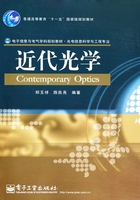
6.5 平面屏幕衍射的瑞利-索末菲理论[1],[4]
尽管基尔霍夫衍射理论给出的结果与实验符合得很好,但在理论上却是不自洽的。基尔霍夫衍射理论的困难源于同时对场强及其法向导数施加边界条件。按照有关数学定理,可以推知,如果三维波动方程的一个解在任意有限的面元上为零,则此解在全空间为零。因此,如果场满足基尔霍夫边界条件,则必然在全空间皆为零,这与客观事实不符。后来,索末菲等人改变了同时对场强及其法向导数施加边界条件的做法,从而解决了基尔霍夫理论中的不自洽问题。
6.5.1 瑞利-索末菲衍射公式
按照以前的讨论,将观察点P的场用整个屏幕面上的场(见图6.5-1)表示为


图6.5-1 平面屏幕衍射的瑞利-索末菲表示法
索末菲巧妙地选择了格林函数,从而避免了积分面S1 上的U和 同时为零的要求,他选择的格林函数为
同时为零的要求,他选择的格林函数为

或者

式中,第一项为中心在观察点P的发散球面波,第二项为以P点相对衍射屏的镜像点P'为中心的发散球面波,r和r'分别为P和P'到屏上任一点P1的距离。两个单位球面波具有相同的波长,相位相反或相同。这时,由式(6.5-2)定义的格林函数给出

因为点P和点P'为镜像关系,在整个衍射屏上恒有

在屏幕面上,有

于是得到

由上式可以看出,由于选择格林函数G-,从而使积分式中只含有复振幅U,不含∂U/∂n,这样只需要对U使用边界条件就可以了,即:
(1)在通光孔上,光场复振幅U的分布与没有屏时U的分布完全相同;
(2)在屏幕背光面上,复振幅U恒为零。
于是便有

令衍射孔由位于P0处的点光源照明,则有

从而得到

上式称为瑞利-索末菲衍射公式,与菲涅耳-基尔霍夫衍射公式(6.4-10)相比,两者的差别仅在于它们的倾斜因子不同。由于瑞利-索末菲衍射理论所用的边界条件仍然是近似的,因此在理论上的自洽性并不表明所得到的结果比菲涅耳-基尔霍夫衍射公式给出的结果具有更高的精度,也不意味着其应用范围更广。
可以将瑞利-索末菲衍射公式写成叠加积分的形式,即

其中

这一结果反映了光场的线性叠加性质。设孔径Σ上任一点P1,其复振幅为U(P1),P1 处的面元dS在观察点产生的复振幅为dU(P)=U(P1)h(P,P1)dS,当U(P1)dS=1时,dU(P)=h(P,P1),可见h(P,P1)表示P1点的单位脉冲在观察点产生的复振幅,因此将h(P,P1)称为脉冲响应,或点扩散函数。
6.5.2 非单色光照明条件下的瑞利-索末菲衍射公式
在以上衍射问题的讨论中,都假设用单色光源照明孔径。但实际上光波都有一定的频率范围,是复色光,复色光场用空间和时间变量的复值函数u(P,t)表示。下面讨论用复色光照明时的衍射问题。假设用复色光 照明孔径Σ,在孔径后的衍射场中某观察点P处的光场为u(P,t)。用傅里叶变换分别将u(P,t)和
照明孔径Σ,在孔径后的衍射场中某观察点P处的光场为u(P,t)。用傅里叶变换分别将u(P,t)和 表示成各单色光成分的线性组合,即
表示成各单色光成分的线性组合,即

以及

U(P,ν)和U(P0,ν)分别是u(P,t)和 的傅里叶频谱,ν为光波的频率。用exp(-i2πνt)表示频率为ν的平面波,令ν'=-ν,则
的傅里叶频谱,ν为光波的频率。用exp(-i2πνt)表示频率为ν的平面波,令ν'=-ν,则

及

对于每一个单色光成分,根据衍射公式有

其中 。将式(6.5-17)代入式(6.5-15)得
。将式(6.5-17)代入式(6.5-15)得

将式(6.5-16)对t求导可得

同理有

因此

上式为复色光的衍射公式。它表明P点的光场是由Σ上各点光振动对时间的导数决定的,由于光波从P0点传到P点需要时间r/c,因此Σ上P0点在时刻t'=t-r/c的光振动对时间的导数对P点的光振动有贡献。
当非单色光满足 时,则称为准单色光
时,则称为准单色光 分别为准单色光的频带宽度和中心频率。对于准单色光,ν'、λ'可以用
分别为准单色光的频带宽度和中心频率。对于准单色光,ν'、λ'可以用 来替换。指数上,当Δ kr≪2π时,近似有
来替换。指数上,当Δ kr≪2π时,近似有

于是

利用式(6.5-16)得到

定义


Ua(P,t)和Ua P0
(,t
)分别是P点及P0 点准单色光的复振幅,它们都是空间和时间的函数。把
式(6.5-25)和式(6.5-26)代入式(6.5-24)得

上式为准单色光的衍射公式,它与理想单色光的形式相同,只是准单色光的复振幅不仅依赖空间变量,也依赖时间变量。